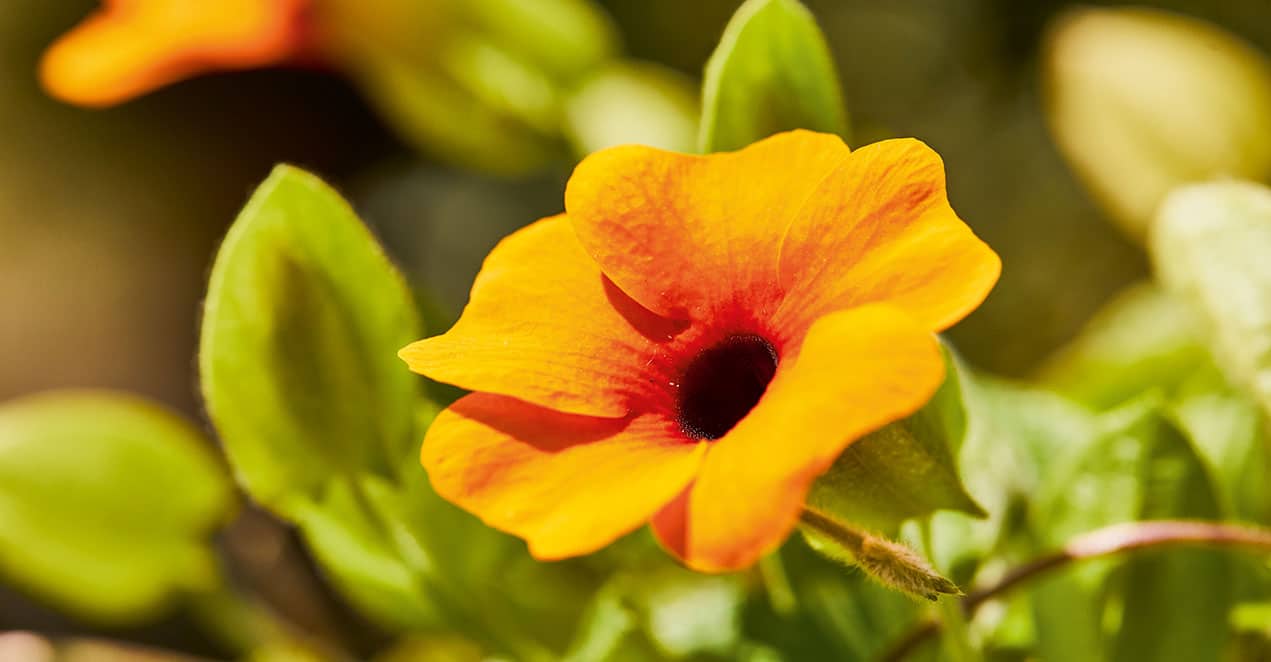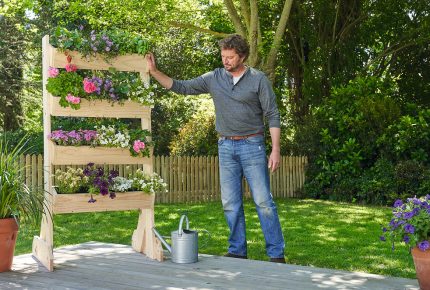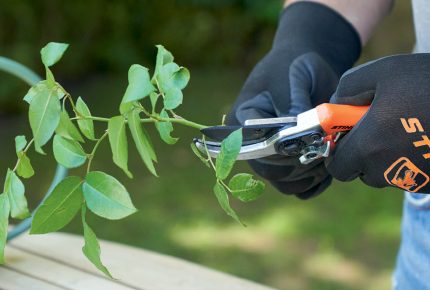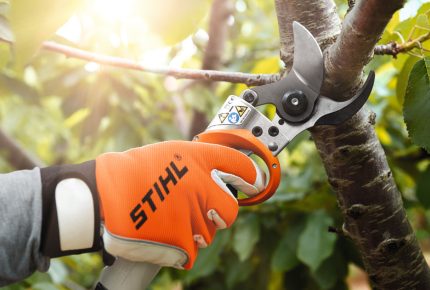
#How To
Spring Gardening: Pruning, Potting & Seed Sowing
Do you want a radiant sea of flowers and magnificent plants in your garden and on your balcony? We’ll tell you which gardening work should be done in the spring, what to consider when repotting, how to make potted plants fit for the season and how to sow seeds successfully.
Pruning potted and contained plants in Spring
Before overwintered container plants are allowed outdoors from November onwards, they need some attention: freeing them from pale winter shoots, pruning, repotting and fertilising. Pruning is about thinning out the plants and cutting off old, dried or overlapping shoots. Many plants can also be shaped by pruning. All you need is one very simple tool: pruning shears. You only need loppers for thick shoots on large container plants.
When can plants start to be pruned?
Generally, there is no fixed pruning date. However, plants should always be cut before the first budding. If you remove fresh shoots later, this will only use up more of the plant’s energy reserves. During overwintering, container plants usually form so-called water sprouts: long, soft, light green or light yellow shoots which develop when there is not enough light. These should be removed at all costs. All plants which overwinter in a winter garden or in a cool, bright place sprout early. These plants can be thinned out well until the end of February, after which they should be placed somewhere warm and bright to prevent new water sprouts from forming again.
To prepare plants which overwintered in the dark for spring, place them somewhere light from the end of September. It’s important that this area is frost-proof. The plants can then start to grow a little before they are allowed outdoors in November. If plants remain in the dark for too long, the flowering period will be delayed.
How to prune your plants correctly
In addition to the water sprouts mentioned above, remove old, dried and damaged twigs. If possible, do not leave any stumps on the branches, but cut off the shoots directly on the stem or a thicker side branch. Branch stumps usually dry out and do not sprout again. Geraniums, fuchsias, daisies and summer-flowering container plants bloom on the new shoots, so hard pruning of up to two to four buds or 5-10 cm of branch length is possible here. This allows them to remain compact and bushy. Oleander, on the other hand, is a biennial and flowers on older shoots. If you want to thin out plants which have grown too big, do not cut them back too much, but do so in stages until the whole plant is reduced in size after a few years. A little patience is worth it, since the alternative is having to go without flowers for a whole year. N.B.: do not simply prune container plants that have grown too big all at one height, but shorten either entire branches or side branches by a third. By doing so, you will add shape to the plant.
An easy rule to remember is the following: the harder the pruning, the longer it takes to flower.
Potting and repotting made easy
With container plants, the pot will eventually become too small and the plant will need to be moved to a larger container. For old potted plants, this may be necessary every two to three years depending on how quickly they grow, and even younger plants may need repotting annually. If the root ball is completely rooted and the roots are already growing out of the water drainage holes, it is definitely time for repotting. It’s not just the size of the pot which plays a part: even if container plants don’t yet have a completely rooted root ball, they still require new soil on a regular basis. The old soil leaches out, loses nutrients and become unstable so that it quickly becomes muddy when it rains. Fresh soil, on the other hand, provides the plant with fresh nutrients, has more water reserves, and you don’t have to water it as much. In contrast, balcony plants should be given new soil every year, whether they have been overwintered or are newly purchased.
Timings and preparation: what you need for repotting
Aside from new soil you need pots or containers for the plants, a hand shovel and fertiliser. For container plants, a long knife can be helpful to remove the root ball from the pot more easily.
Newly-purchased balcony plants can be potted in a new container straight away. However, the plants should not be placed outdoors until mid-May due to the risk of late frosts. Plants may still be stored temporarily in a suitable frost-proof place.
Overwintered balcony plants can also be repotted in fresh soil from mid to late April. This is best done when the plants have been removed from their winter storage and pruned. Then place the plant in a lighter location.
Finding suitable soil and containers
Choosing the right soil depends entirely on the length of time the plant will be in the pot. For seasonal planting, you can therefore fall back on a good own brand from a garden centre; peat-free soil is preferable for environmental reasons. If a plant is to remain in the pot for longer, such as container plants, a high-quality, branded potting soil is recommended. There is no need to resort to special soil until several plants of the same kind end up in one container. Citrus plants, hydrangeas and azaleas are an exception, as they need a special acidic soil.
When selecting a suitable container, make sure that it has a wide base and is not higher than it is wide. This ensures that it won’t tip over easily. Gravel used as drainage can weigh the container down and make it even more stable. The classics are pots made of clay and terracotta. These are heavy, but still have their advantages: the material protects the roots from heat in sunny locations and from frost in winter. If you want to overwinter the pots outdoors, make sure that they don’t draw water – this means the clay will no longer be frost-proof and could become damaged.
For those who like the aesthetics of stone and terracotta but would prefer a cheaper version, there are also many plastic pots to be found in the same design. A plastic pot generally keeps the soil moist for longer because no water can evaporate through the walls. A final piece of advice: make sure that the pot has a water drainage hole. Waterlogging can harm any plant.
Instructions for potting and repotting
Newly-purchased balcony plants should be potted whilst overwintered container plants are repotted into larger pots. And here’s how it works:
- The new pot should be two fingers wider than the old one.
- For very large plants that you don’t want to move to a larger pot, you can just reduce the size of the root ball. To do so, remove the plant from the container and cut the root ball all the way around with a long knife until it looks like a cube. Then put the plant back in the old pot with fresh soil.
- Place crocks over the water drainage holes and water can still drain around the clay.
- Place a cotton cloth or newspaper over the drainage hole to prevent soil from escaping.
- Fill with some soil, then insert the plants and fill the container almost to the brim.
- Press on the plants gently with both hands so that 2-3 centimetres remain between the top of the soil and the edge of the pot, depending on its size.
Tricks to make potting and repotting easier
- The drainage holes should only be a few centimetres thick, otherwise they will be too effective and the pot will be drained. Drainage ensures that excess water finds its way out of the pot.
- If possible, place the container on flat stones or feet so that ants cannot get inside so easily and water can drain out better.
- Having adequate space between the soil level and the top of the pot is particularly useful for thirsty plants. Instead of pouring the water slowly and carefully onto the plant, you can simply pour the water normally and it will be held within this space, similarly to a collecting basin, and will then slowly trickle away.
- Mulching also works in a container. Gravel has proven itself, but grass cuttings can also be used.
- Mineral fertilisers are the best option. Organic fertilisers often work too slowly in balcony containers and in seasonal plants there is no need to improve the soil.
- Reservoir boxes: self-sufficiency with the built-in tank only works after four weeks. That’s how long plants need to take root. Until then, you also have to water these boxes normally.
Seed sowing in Spring
The selection of young plants in the garden centre cannot compete with the variety of seeds. Seed bags are also much cheaper than young plants. And another advantage: if you are looking for rare plants, sowing them is the best option since they often don’t exist as young plants. Here you can read more about what is important to consider when sowing.
Preparation and materials for sowing
You will need: seeds, a wide ruler as a wooden stick, seed trays, a wide piece of wood to press on, multi-pot pallets or small pots and sowing soil.
In general, only use special sowing soil because it is low in nutrients and therefore ensures that the seedlings do not become inactive. They are thus forced to form many roots to cover their nutrient needs. The resulting shoots later ensure that the young plants develop into strong plants in the right soil. If you sow directly into the field, then sowing soil is not necessary.
When sowing, you should always pay attention to hygiene and clean old seed containers with hot water, as the young plants are very sensitive. Harmful fungi can damage the seed or destroy it completely. Summer flowers in particular can be sown directly into the bed from May onwards, thus avoiding the need for a preculture on the windowsill. In the case of root vegetables such as carrots, things are no different as you cannot replant them from the sowing container into the bed. A preculture, however, is absolutely necessary for some plants (e.g. tomatoes or aubergines) which need a lot of warmth for germination.
How to proceed with sowing
The seed size determines whether you sow in single pots or seed trays. Large seeds can be placed directly in a pot, individually or two by two, in which they thrive until they come into the open. Small seeds are placed in flat sowing trays where they grow in large numbers. Here’s how to proceed: fill half of the tray with soil and press lightly with your fingers. Fill the container completely so that the soil in the middle of the tray protrudes clearly above the edge. Then remove the excess with the wooden stick. Hold it slightly at an angle of 45° – and pull it over the edge of the tray. This automatically compresses the soil further. Then press the soil slightly with a wide piece of wood so that a slight curvature is created towards the edge. Now evenly distribute the seeds directly from the seed bag into the seed tray and sift over them with some soil. Tip: mix extremely small seeds such as begonias with bird sand and distribute the mixture into the tray using a tea strainer. The seedlings from the tray must be pricked into small pots before they can be planted out – as soon as they can be gripped by the cotyledon. Only use the strongest seedlings when pricking.
The best way to water the seeds is with a watering globe used in the florist industry. Now the seed needs to be covered with a film hood. If you don’t have a propagator available, then plastic film or clingfilm is sufficient. This enables the seeds to retain more moisture.
Seedlings often grow towards the light source and become crooked. With a simple trick, however, the seedlings remain straight: place the seed trays in a cardboard box with one side left open. Stick aluminium foil in this box so that the incident light is reflected. Seedlings grown in such a light box become much stronger.
Colourful, mixed, hanging: the right mixture for spring
There are no limits when it comes to choosing plants for a container, balcony box, or the garden. The only thing that should be similar is the preferred location of the plants so that they can flourish. In principle, it is advisable to place smaller plants at the front and the larger ones at the back. Whether you choose a colourful mix of different flowers or stick to monochrome harmony – it’s all down to your own creativity. Roll on spring!






